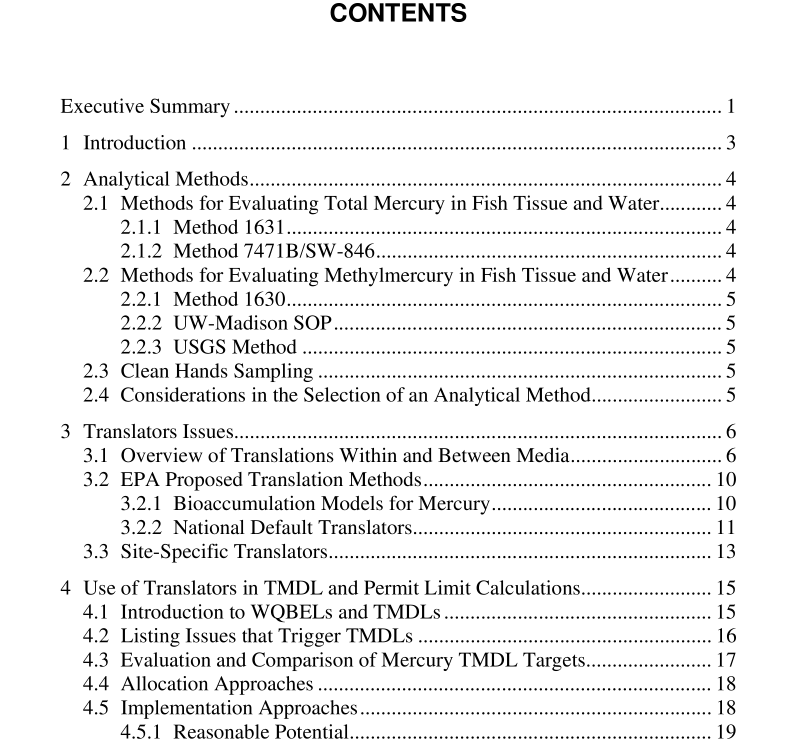API PUBL 4751 pdf download

API PUBL 4751 pdf download.Evaluation of Water Quality Translators for Mercury
The translation from methylmercury in fish to total mercury in water can be viewed as a single step (i.e., the direct method) or a multi-step process. In the direct method, total mercury in fish is directly translated to total mercury in water. In contrast, in the multi-step approach methylmercury in fish is converted to dissolved methylmercury in water and then to total mercury in water. The major challenge in developing mercury translators is the enormous variability in the site-specific potential for mercury methylation and bioaccumulation. Among the important factors that contribute to the variability in mercury bioavailability and bioaccumulation are pH, dissolved organic carbon (DOC), salinity, water flow (e.g., stream flow, lake flushing rate, etc.), temperature, reduction-oxidation potential, sulfide and sulfate, suspended solids, nutrient loading, fish age and size, prevalence of wetlands and forested land cover in the watershed, and concentration-dependent demethylation (Brumbaugh et al. 2001; Qian et al. 2001; Kamman et al. 2004; Marvin-DiPasquale et al. 2000; Sonesten 2003a; Rose et al. 1999; Ullrich et al. 2001; Watras et al. 1998). EPA (2002a, 2004a) draft guidance recommends the following approaches to criteria translation, in order of preference: (1) derive site-specific bioaccumulation factors (BAFs), (2) use a bioaccumulation model, or (3) use EPA’s national default translators (EPA 2004a). EPA (2004a) does not recommend any specific bioaccumulation models for mercury, although a modeling approach is preferred over the use of default translators. Despite extensive study, there are no accurate, nationally applicable models for predicting mercury bioaccumulation. As an alternative to process-based or mechanistic mathematical models, the draft EPA guidance suggests that regression models incorporating such variables as pH, DOC, and fish age may be acceptable for criteria translation purposes.
For many facilities, the major issue in developing mercury translators is incorporating the fish tissue mercury criterion into a discharge permit limit. Permits may be reopened and reassessed as part of a TMDL implementation. At least 45 states have fish consumption advisories due to mercury and over 1,000 water bodies are listed as being impaired due to mercury, thus triggering TMDLs. Several methods are generally used in developing mercury TMDLs: (1) the concentration in fish tissue; (2) the concentration in the water column; or (3) the concentration in sediment. Of the three methods, using a fish tissue concentration as the TMDL target is the most direct measure of the desired endpoint, protection of human health. Determining how to allocate loadings among point and nonpoint sources is the next major part of a TMDL. EPA (2002a, 2004a) offers three approaches to allocation of loadings, depending upon the relative contributions of point source and nonpoint source loadings. First, where point source loadings dominate, the TMDL should specify reductions in these loadings, alone or together with nonpoint source loadings, to attain water quality standards (WQS). Second, where point source loadings are small, reductions in nonpoint sources are expected to achieve the TMDL. The third scenario also involves relatively small contributions from point sources, but reductions in nonpoint sources are not expected to be sufficient to attain WQS. The approaches used to implement a mercury TMDL will vary depending upon the allocations, as described above. Where there are waste load allocations (WLAs) to point sources, the traditional method to implement a TMDL is likely to be used (i.e., through the NPDES permit). The implementation of effluent limitations for mercury and other pollutant parameters can be approached through several mechanisms including reasonable potential and development of WQBELs.









